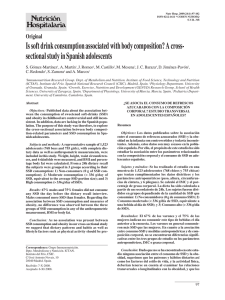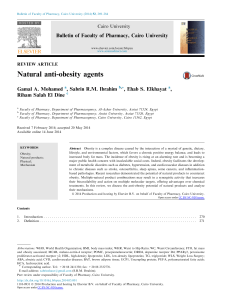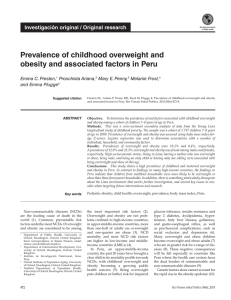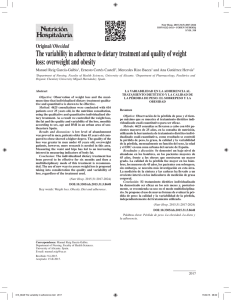The need for an international debate in pediatrics about obesity and
Anuncio
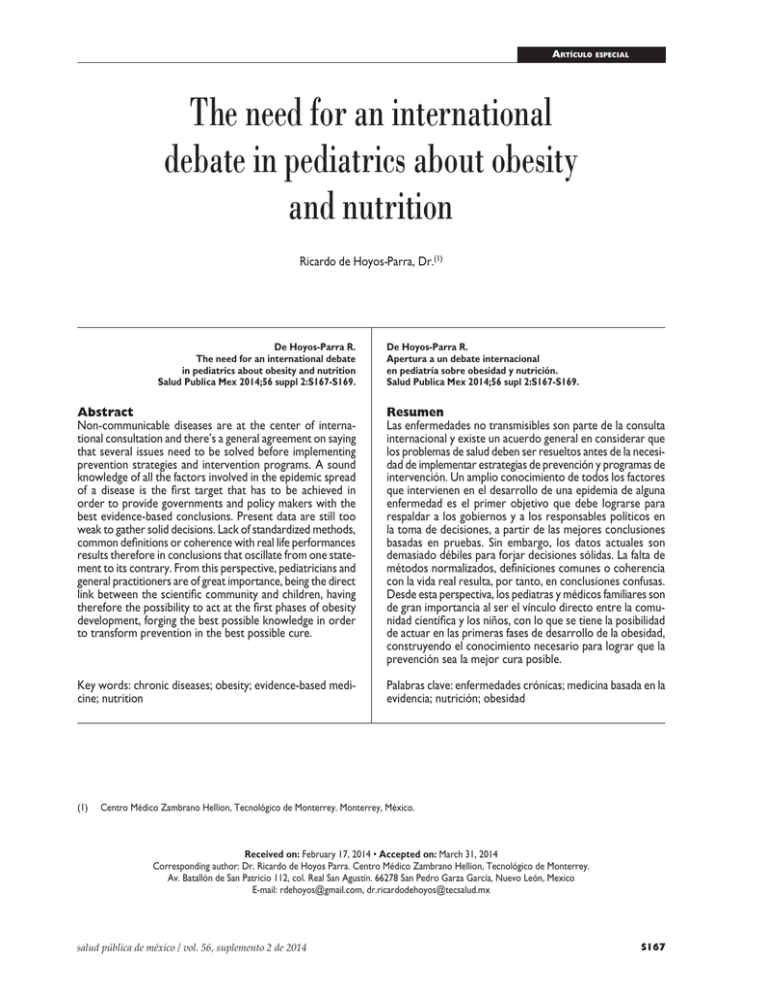
International debate about pediatric obesity Artículo especial The need for an international debate in pediatrics about obesity and nutrition Ricardo de Hoyos-Parra, Dr.(1) De Hoyos-Parra R. The need for an international debate in pediatrics about obesity and nutrition Salud Publica Mex 2014;56 suppl 2:S167-S169. De Hoyos-Parra R. Apertura a un debate internacional en pediatría sobre obesidad y nutrición. Salud Publica Mex 2014;56 supl 2:S167-S169. Abstract Non-communicable diseases are at the center of international consultation and there’s a general agreement on saying that several issues need to be solved before implementing prevention strategies and intervention programs. A sound knowledge of all the factors involved in the epidemic spread of a disease is the first target that has to be achieved in order to provide governments and policy makers with the best evidence-based conclusions. Present data are still too weak to gather solid decisions. Lack of standardized methods, common definitions or coherence with real life performances results therefore in conclusions that oscillate from one statement to its contrary. From this perspective, pediatricians and general practitioners are of great importance, being the direct link between the scientific community and children, having therefore the possibility to act at the first phases of obesity development, forging the best possible knowledge in order to transform prevention in the best possible cure. Resumen Las enfermedades no transmisibles son parte de la consulta internacional y existe un acuerdo general en considerar que los problemas de salud deben ser resueltos antes de la necesidad de implementar estrategias de prevención y programas de intervención. Un amplio conocimiento de todos los factores que intervienen en el desarrollo de una epidemia de alguna enfermedad es el primer objetivo que debe lograrse para respaldar a los gobiernos y a los responsables políticos en la toma de decisiones, a partir de las mejores conclusiones basadas en pruebas. Sin embargo, los datos actuales son demasiado débiles para forjar decisiones sólidas. La falta de métodos normalizados, definiciones comunes o coherencia con la vida real resulta, por tanto, en conclusiones confusas. Desde esta perspectiva, los pediatras y médicos familiares son de gran importancia al ser el vínculo directo entre la comunidad científica y los niños, con lo que se tiene la posibilidad de actuar en las primeras fases de desarrollo de la obesidad, construyendo el conocimiento necesario para lograr que la prevención sea la mejor cura posible. Key words: chronic diseases; obesity; evidence-based medicine; nutrition Palabras clave: enfermedades crónicas; medicina basada en la evidencia; nutrición; obesidad (1) Centro Médico Zambrano Hellion, Tecnológico de Monterrey. Monterrey, México. Received on: February 17, 2014 • Accepted on: March 31, 2014 Corresponding author: Dr. Ricardo de Hoyos Parra. Centro Médico Zambrano Hellion, Tecnológico de Monterrey. Av. Batallón de San Patricio 112, col. Real San Agustín. 66278 San Pedro Garza García, Nuevo León, Mexico E-mail: [email protected], [email protected] salud pública de méxico / vol. 56, suplemento 2 de 2014 S167 Artículo especial T he debate on non-communicable diseases (NCDs) has fired up in September 2011, when, for the second time in history, United Nations’ (UN) General Assembly met on a health issue.1 Among NCDs, nutrition related diseases, like diabetes and obesity, are at the center of International consultation, and CDC is advocating four modifiable health risk behaviors (lack of physical activity, poor nutrition, tobacco use, and excessive alcohol consumption) as responsible for much of the illnesses.2 When getting deeper in this debate, several issues need to be solved before implementing prevention strategies and intervention programs. A sound knowledge of all the factors involved in the epidemic spread of a disease is the first target to be achieved. The actual plague therefore requires a wise evaluation in order to sustain governments and policy makers with the best evidence-based conclusions.3 As highlighted in the present monographic volume, nutrition research is still a highly disputed field. Obesity’s risk factors have been widely investigated. When considering for example sugar sweetened beverages (SSBs), several meta-analysis assessing impact on nutrition related diseases stated that decreasing SSBs consumption could reduce the prevalence of this diseases.4,5 However some papers address the same issues advocating potentially distorting effects of data presentation.6,7 Without eventually proving that the previous results are wrong. Taken the sound results found for this risk factor, efficient policies could be implemented in order to tackle obesity limiting this risk factor.8 Unfortunately, the panorama for other research and specific risk factors is still not so sound. Several authors9-11 registered the lack of a standardized methods, missing common definitions or coherence with real life performances, and in most of cases considering only specific subjects (for example, just overweight children). The absence of common grounds in this specific type of research results therefore in conclusions that broaden from one statement to its contrary. The absence of international standards, for example in food labeling and profiling, calls for an urgent development of definitions accepted and shared from the whole scientific community, that can be consequently communicated to the population. The UN has clearly declared that behavior-focused communication messages on nutrition and health are critical step in creating positive behavior change to impact health.12 Multiple-concurrent interventions to tackle obesity are highly demanded. It’s proven from the constant and rapid epidemic that focusing on a single intervention in isolation, holding all other factors constant, makes each individual policy change to appear ineffective.13 S168 De Hoyor-Parra R Behavioral aspects of obesity development are modifiable factors that need to be analyzed and properly addressed. Banning policies and taxation have been nowadays the most beaten tracks. But the question whether these actions are sufficient alone to reach the target is still open. The obesogenic environment indeed appears to be smoothening the rapid spread obesity, by providing virtually unlimited access to inexpensive, energy-dense food, while decreasing the need for prolonged periods of physical activity.14 The strong efforts from scientists first and policy makers secondly may be fruitless if not backed up by a system synergically focused to minimize high energy intake conditions and increase high energy expenditure occasions. As suggested within September’s meeting, high importance must be given to a comprehensive and integrated approach involving prevention, treatment and long-term care.12 The effort that need therefore to be taken doesn’t involve solely the industry, to whom is strongly asked to reformulate in order to hold back children’s energy intake, but includes also governments, that should modify the built environment to promote physical activity also has the potential to prevent obesity15 and health professionals, that are involved in children’s growth and that can directly reach families, representing for them a source of information and guidance. Taken the global proportion of the disease, efficacy and cost-effectiveness need to be established within a common framework. Within the global melting pot, country specific issues and peculiarities must be taken into account when considering obesity. Developing and developed countries share the same urgency to find and improve programs to limit and reverse the present situation, but the environment they’re floating in is not a common one. Food insecurity and lack of nutritional knowledge are still sensitive problems in countries where undernutrition and overweight coexist, almost equally sharing children’s population. On the other side, developed countries appear to be fighting against a new sedentary dimension, where childhood has replaced playgrounds with digital games and television. So, who/what is to blame? Eventually this question, that has been repeatedly answered or avoided, has to be modified. Obesity in children is nowadays one of the major diseases, with a worldwide distribution. Heavy children are destined to become a heavy burden for health systems in their adulthood, due to the wide spectrum of related chronic diseases, as for example diabetes, obesity’s twin. What the scientific community should be able to answer is “who/what is to reward?” Evidence based policies that effectively work in decreasing childhood’s obesity prevalence should be regarded salud pública de méxico / vol. 56, suplemento 2 de 2014 International debate about pediatric obesity as example within the whole scientific community, and implemented, after carefully considering the cultural and economic background in every country. Education and nutritional awareness should be the starting point within each community, taken that parents’ misperception of children nutritional status is often one of the commonest hurdles that need to be cleared when starting an intervention. Family-based lifestyle interventions with a behavioral program aimed at sustainably changing the family’s lifestyle have been shown to result in significant and clinically meaningful decrease in childhood overweight.16 From this perspective, pediatricians and general practitioners are of great importance, being the direct link between the scientific community and children, having therefore the possibility to act at the first phases of obesity development. Forecasts say that by 2030 NCDs will be the most common causes of death. It’s our scope as scientists and citizens to reverse this predicted future, forging the best possible knowledge in order to transform prevention in the best possible cure. Declaration of conflict of interests. The authors declare that they have no conflict of interests. References 1. Koehlmoos TP. UN meeting for non-communicable diseases. BMJ 2011;343:d5762. 2. Suellentrop K, Morrow B, Williams L, D'Angelo D. Monitoring progress toward achieving Maternal and Infant Healthy People 2010 objectives--19 states, Pregnancy Risk Assessment Monitoring System (PRAMS), 20002003. MMWR Surveill Summ 2006;55(9):1-11. 3. Rosenbaum SE, Glenton C, Wiysonge CS, Abalos E, Mignini L, Young T, et al. Evidence summaries tailored to health policy-makers in low- and middle-income countries. Bull World Health Organ 2011;89(1):54-61. salud pública de méxico / vol. 56, suplemento 2 de 2014 Artículo especial 4. Hu FB. Resolved: there is sufficient scientific evidence that decreasing sugar-sweetened beverage consumption will reduce the prevalence of obesity and obesity-related diseases. Obes Rev 2013;14(8):606-619. 5. Malik VS, Schulze MB, Hu FB. Intake of sugar-sweetened beverages and weight gain: a systematic review. Am J Clin Nutr 2006;84(2):274-288. 6. Menachemi N, Tajeu G, Sen B, Ferdinand AO, Singleton C, Utley J, et al. Overstatement of results in the nutrition and obesity peer-reviewed literature. Am J Prev Med 2013;45(5):615-621. 7. Thomas O, Thabare L, Douketis J, Chu R, Westfall AO, Allison DB. Industry funding and the reporting quality of large long-term weight loss trials. Int J Obes (Lond) 2008;32(10):1531-1536. 8. Moise N, Cifuentes E, Orozco E, Willet W. Limiting the consumption of sugar sweetened beverages in Mexico’s obesogenic environment: a qualitative policy review and stakeholder analysis. J Public Health Policy 2011;32(4):458-475. 9. Phillips CM, Dillon C, Harrington JM, McCarthy VJ, Kearney PM, Fitzgerald AP, Perry IJ, et al. Defining metabolically healthy obesity: role of dietary and lifestyle factors. PLoS One 2013;8(10): e76188. 10. Gregori DC. Maffeis C. Snacking and obesity: urgency of a definition to explore such a relationship. J Am Diet Assoc 2007;107(4):562; discussion 562-3. 11. Farrell B, Kenyon S, Shakur H. Managing clinical trials. Trials 2010;11:78. 12. Beaglehole R, Bonita R, Alleyne G, Horton R, Li L, Lincoln P, et al. UN High-Level Meeting on Non-Communicable Diseases: addressing four questions. Lancet 2011;378(9789):449-455. 13. Kersh R, Stroup DF, Taylor WC. Childhood obesity: a framework for policy approaches and ethical considerations. Prev Chronic Dis 2011;8(5):A93. 14. Selassie M, Sinha AC. The epidemiology and aetiology of obesity: a global challenge. Best Pract Res Clin Anaesthesiol 2011;25(1):1-9. 15. Beaglehole R, Bonita R, Hurton R, Adams C, Alleyne G, Asaria P, et al. Priority actions for the non-communicable disease crisis. Lancet 2011;377(9775):1438-1447. 16. Alff F, Markert J, Zschaler S, Gausche R, Kiess W, Blüher S. Reasons for (non)participating in a telephone-based intervention program for families with overweight children. PLoS One 2012;7(4):e34580. S169
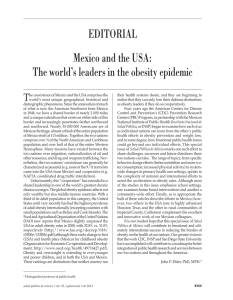
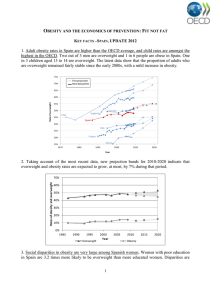
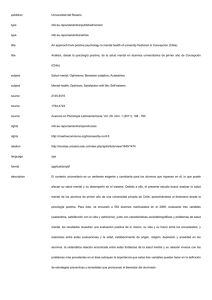
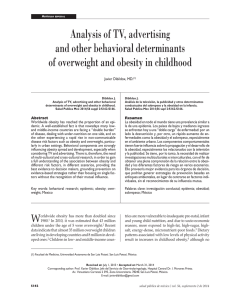
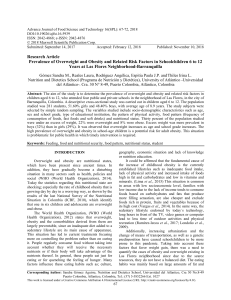
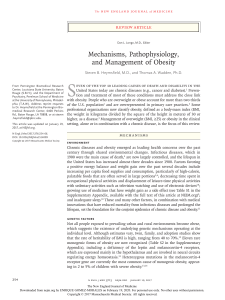
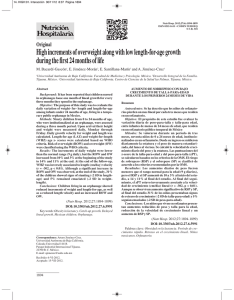
![[] Diabetes Mellitus, Obesity and Underlying Non Alcoholic Fatty Liver Disease - Independent Risk Factors for Hepatocellular Carcinoma](http://s2.studylib.es/store/data/008839203_1-639d2cfd5f7307c887258689d2f3b694-300x300.png)
